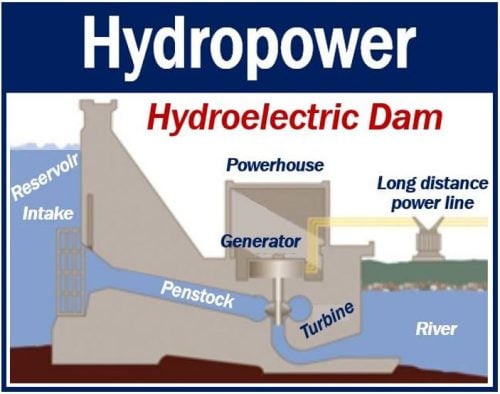What is hydropower? Definition and meaning
Hydropower refers to capturing the energy in flowing or falling water and converting it into electricity. Historically, humans have also used hydropower to grind, for example, grain into flour.
We also use the terms hydro energy and water energy with the same meaning. When we convert the energy into electricity, we refer to that energy as hydroelectricity.
We have also used hydro energy to operate sawmills, textile mills, dock cranes, ore mills, and for irrigation.
Hydropower to generate electricity
In the nineteenth century, hydro energy began to become a source for generating electricity.
The first house to use hydroelectricity was Cragside, in Northumberland, England, in 1878. In 1879, in Niagara Falls, the first commercial hydroelectric power plant began generating electricity. Two years later, the city of Niagara Falls used hydroelectricity to power its street lights.
Origin, Australia’s leading energy retailer, has the following definition of the term:
“Hydropower, or hydro energy, is a form of renewable energy that uses the water stored in dams, as well as flowing in rivers to create electricity in hydropower plants.”
For the past 100 years, we have used the term ‘hydropower’ nearly exclusively in conjunction with the generation of hydroelectricity.

Hydropower – national economies
Hydro energy helps emerging economies develop without adding CO2 to the atmosphere. However, dams can have detrimental environmental and social impacts.
Hydroelectricity accounted for approximately 7.5% of the United States’ utility-scale electricity generation in 2017. It represented 44% of total utility-scale electricity generation from renewable energy.
However, over the past few decades, as a share of total US electricity generation, hydropower has declined. This is because other types of electricity generation have increased.
Hydropower – the water cycle
Hydropower relies on what we call ‘the water cycle.’ Understanding the water cycle is crucial to understanding hydropower.
According to the US Energy Information Administration, the water cycle consists of three steps:
1. Solar energy heats water
Energy from the Sun, solar energy, heats water on the surface of the oceans. It also heats water on the surface of lakes and rivers.
The heat causes the water to evaporate.
2. Clouds form
The water vapor subsequently condenses, forming clouds. The water in the clouds then falls as rains and snow. We call this rain and snow ‘precipitation.’
3. Precipitation collects, then evaporates again
The precipitation collects in rivers and streams. The water from rivers and streams flows into oceans and lakes. Solar energy then heats the water on the surface of lakes, oceans, etc., and so the cycle continues.
Regarding the amount of rain and snow that drains into rivers and streams, the US Energy Information Administration says:
“The amount of precipitation that drains into rivers and streams in a geographic area determines the amount of water available for producing hydropower.”
“Seasonal variations in precipitation and long-term changes in precipitation patterns, such as droughts, have a big impact on hydropower production.”
A hydro plant
Most hydro plants have three parts:
1. The electric plant
The electric plant generates electricity.
2. A dam
The dam opens and closes. We open and close it to control the flow of water.
3. A reservoir
We store the water in the reservoir.
According to National Geographic:
“The water behind the dam flows through an intake and pushes against blades in a turbine, causing them to turn. The turbine spins a generator to produce electricity.”
“The amount of electricity that can be generated depends on how far the water drops and how much water moves through the system. The electricity can be transported through long-distance electric lines to homes, factories, and businesses.”
Russia, the United States, Brazil, Canada, and China are major producers of hydropower.
The Three Gorges hydro plant on China’s Yangtze River is huge. Its dam is 2.3 kilometers (1.4 miles) wide and 185 meters (607 feet) high.
The Three Gorges has a generating capacity of 22,500 MW. It is the largest hydroelectric plant in the world.
Hydropower is renewable energy
Renewable energy is energy whose source is everlasting; it never runs out. In other words, we cannot use it all up so that there is none left. It is everlasting, that is, in a human timescale.
Solar power, wind power, and biomass are types of renewable energy. Geothermal power is also renewable energy.
The energy from the Sun, solar power’s source, is always there. The energy from moving air, wind power’s source, is also always there.
The source of geothermal energy is the Earth’s inner heat. That inner heat is also everlasting in a human timescale.

